Page 48 of 578
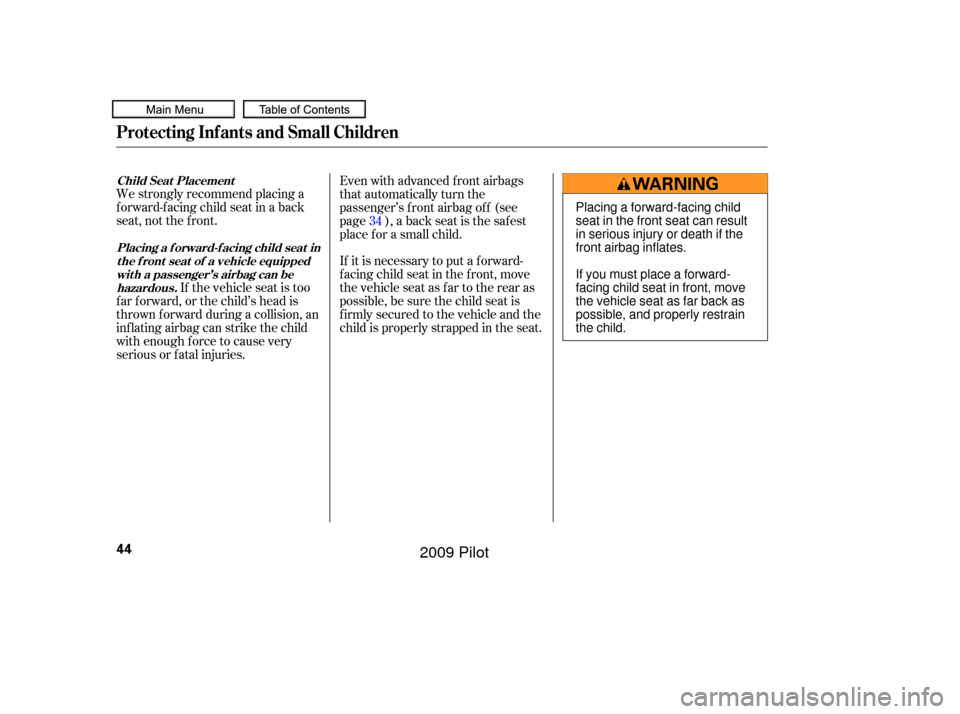
We strongly recommend placing a
forward-facing child seat in a back
seat, not the f ront.If it is necessary to put a f orward-
f acing child seat in the f ront, move
the vehicle seat as far to the rear as
possible, be sure the child seat is
f irmly secured to the vehicle and the
child is properly strapped in the seat.
If the vehicle seat is too
f ar f orward, or the child’s head is
thrown f orward during a collision, an
inf lating airbag can strike the child
with enough force to cause very
serious or fatal injuries. Even with advanced front airbags
that automatically turn the
passenger’s front airbag off (see
page ), a back seat is the saf est
place f or a small child.
34
Protecting Inf ants and Small Children
Child Seat Placement
Placing a f orward-f acing child seat inthe f ront seat of a vehicle equippedwith a passenger’s airbag can behazardous.
44
Placing a forward-facing child
seat in the front seat can result
in serious injury or death if the
front airbag inflates.
Ifyoumustplaceaforward-
facing child seat in front, move
the vehicle seat as far back as
possible, and properly restrain
the child.
�����—�����—�
���y�
�������������y���
�(�/���������y���������y
2009 Pilot
Page 59 of 578
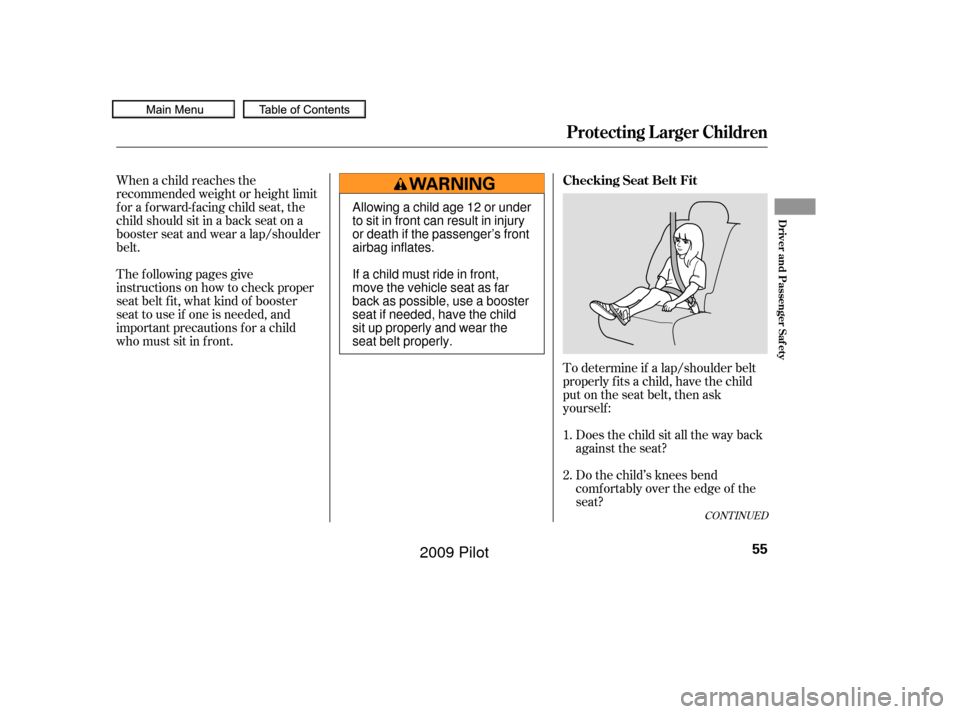
When a child reaches the
recommended weight or height limit
for a forward-facing child seat, the
child should sit in a back seat on a
booster seat and wear a lap/shoulder
belt.
The f ollowing pages give
instructions on how to check proper
seat belt f it, what kind of booster
seat to use if one is needed, and
important precautions f or a child
who must sit in f ront.To determine if a lap/shoulder belt
properly f its a child, have the child
put on the seat belt, then ask
yourself :Does the child sit all the way back
against the seat?
Do the child’s knees bend
comf ortably over the edge of the
seat?
1.
2.
CONT INUED
Checking Seat Belt Fit
Protecting L arger Children
Driver and Passenger Saf ety
55
Allowing a child age 12 or under
to sit in front can result in injury
or death if the passenger’s front
airbag inflates.
If a child must ride in front,
move the vehicle seat as far
back as possible, use a booster
seat if needed, have the child
sit up properly and wear the
seat belt properly.
�����—�����—�
���y�
�������������y���
�(�/���������y���������y
2009 Pilot
Page 61 of 578
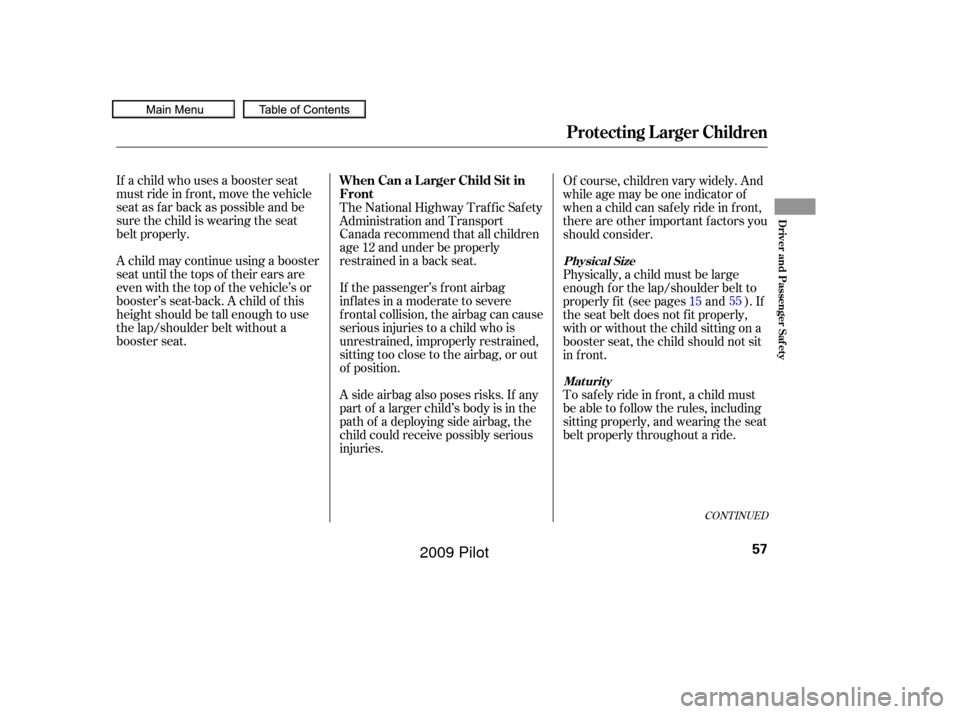
If a child who uses a booster seat
must ride in f ront, move the vehicle
seat as far back as possible and be
sure the child is wearing the seat
belt properly.
A child may continue using a booster
seat until the tops of their ears are
even with the top of the vehicle’s or
booster’s seat-back. A child of this
height should be tall enough to use
the lap/shoulder belt without a
booster seat.The National Highway Traffic Safety
Administration and Transport
Canada recommend that all children
age 12 and under be properly
restrained in a back seat.
If the passenger’s front airbag
inf lates in a moderate to severe
f rontal collision, the airbag can cause
serious injuries to a child who is
unrestrained, improperly restrained,
sitting too close to the airbag, or out
of position.
A side airbag also poses risks. If any
part of a larger child’s body is in the
path of a deploying side airbag, the
child could receive possibly serious
injuries.Of course, children vary widely. And
while age may be one indicator of
when a child can saf ely ride in f ront,
there are other important f actors you
should consider.
Physically, a child must be large
enough f or the lap/shoulder belt to
properly f it (see pages and ). If
the seat belt does not f it properly,
with or without the child sitting on a
booster seat, the child should not sit
in f ront.
To saf ely ride in f ront, a child must
be able to f ollow the rules, including
sitting properly, and wearing the seat
belt properly throughout a ride.
15
55
CONT INUED
When Can a L arger Child Sit in
Front
Physical Size
Maturity
Protecting L arger Children
Driver and Passenger Saf ety
57
�����—�����—�
���y�
���������
���y���
�(�/���������y���������y
2009 Pilot
Page 68 of 578
�Î
�Î
�Î�Î
�Î
�Î
�Î �Î
: If equipped
Control L ocations
64
POWER WINDOW
SWITCHES POWER DOOR LOCK
MASTER SWITCH
HOOD RELEASE
HANDLE HEADPHONE
CONNECTORS
INSTRUMENT PANEL
INDICATORS
GAUGES
Vehicle with navigation system is shown. DRIVER’S FRONT
AIRBAG
(P.9,
27)
(P.136)
(P.163) FUEL FILL DOOR
RELEASE HANDLE
(P.399)
(P.143) (P.80)
MOONROOF SWITCH
(P.166) HomeLink
BUTTONS MIRROR CONTROL
AUTO BUTTON
HEATING/COOLING
CONTROLS
AUTOMATIC
TRANSMISSION
REAR HEATING/
COOLING CONTROLS AUDIO SYSTEM
(P.356)
(P.
168)
(P. 206 )
(P.190 )
CLIMATE CONTROL
SYSTEM (P
.197)
(P. 417 )
(P. 195 )
REAR CLIMATE
CONTROL SYSTEM
(P. 202 )
PARKING BRAKE
PEDAL (P.167)
(P.401) ACCESSORY POWER
SOCKET
(P.346)
PARKING BRAKE
RELEASE HANDLE DRIVING POSITION
MEMORY SYSTEM
(P.171)
(P.167) (P.65)
GLASS HATCH
RELEASE BUTTON/
POWER TAILGATE
SWITCH (P.184)AUXILIARY INPUT
JACKS (P.345)
�����—�����—�
���y�
����
��������y���
�(�/���������y���������y
2009 Pilot
Page 69 of 578
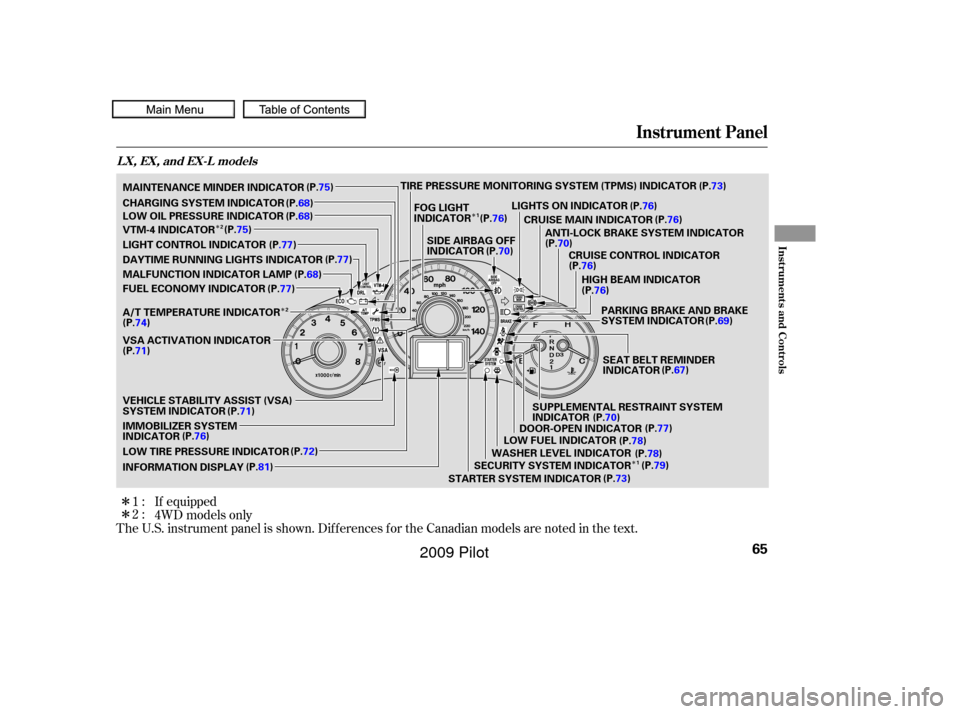
�Î
�Î
�Î
�Î
�Î
�Î
The U.S. instrument panel is shown. Dif f erences f or the Canadian models are noted in the text. 4WD models only If equipped
1:
2:
Instrument Panel
LX, EX, and EX-L models
Inst rument s and Cont rols
65
HIGH BEAM INDICATOR
LIGHTS ON INDICATOR
CRUISE CONTROL INDICATOR
CRUISE MAIN INDICATOR
PARKING BRAKE AND BRAKE
SYSTEM INDICATORSEAT BELT REMINDER
INDICATOR
TIRE PRESSURE MONITORING SYSTEM (TPMS) INDICATOR
SIDE AIRBAG OFF
INDICATOR
FOG LIGHT
INDICATOR
ANTI-LOCK BRAKE SYSTEM INDICATOR
MAINTENANCE MINDER INDICATOR
CHARGING SYSTEM INDICATOR
LOW OIL PRESSURE INDICATOR
VTM-4 INDICATOR
LIGHT CONTROL INDICATOR
DAYTIME RUNNING LIGHTS INDICATOR
MALFUNCTION INDICATOR LAMP
FUEL ECONOMY INDICATOR
IMMOBILIZER SYSTEM
INDICATOR
LOW TIRE PRESSURE INDICATOR
INFORMATION DISPLAY VSA ACTIVATION INDICATOR
VEHICLE STABILITY ASSIST (VSA)
SYSTEM INDICATOR A/T TEMPERATURE INDICATOR
STARTER SYSTEM INDICATORDOOR-OPEN INDICATOR
SUPPLEMENTAL RESTRAINT SYSTEM
INDICATOR
SECURITY SYSTEM INDICATOR WASHER LEVEL INDICATORLOW FUEL INDICATOR
(P.75)
(P.68)
(P.75) (P.68)
(P .77)
(P.77)
(P.74)
(P.71) (P.77)
(P.72)
(P.71)
(P.76)
(P.81) (P.
73)
(P.76)
(P.70) (P.
76)
(P. 76)
(P.70) (P.76)
(P.76)
(P.69)
(P. 67)
(P. 70)
(P.78)(P.79)
(P.78)
(P.
77)
(P.68)
(P.73)
1
2
2
1
�����—�����—�
���y�
�������������y���
�(�/���������y���������y
2009 Pilot
Page 70 of 578
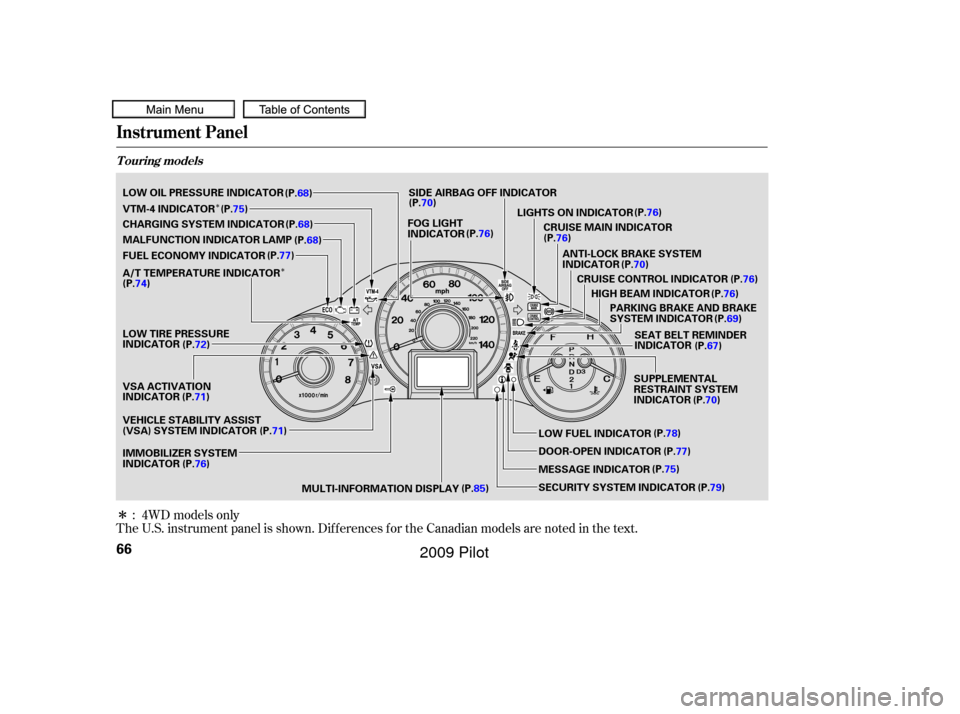
�Î
�Î�Î
The U.S. instrument panel is shown. Dif f erences f or the Canadian models are noted in the text.: 4WD models only
Instrument Panel
T ouring models
66
ANTI-LOCK BRAKE SYSTEM
INDICATOR
HIGH BEAM INDICATOR
SIDE AIRBAG OFF INDICATOR
CRUISE MAIN INDICATOR
FOG LIGHT
INDICATOR
PARKING BRAKE AND BRAKE
SYSTEM INDICATORSEAT BELT REMINDER
INDICATOR
SUPPLEMENTAL
RESTRAINT SYSTEM
INDICATOR
DOOR-OPEN INDICATOR
MESSAGE INDICATOR
SECURITY SYSTEM INDICATOR
LOW OIL PRESSURE INDICATOR
VTM-4 INDICATOR
CHARGING SYSTEM INDICATOR
MALFUNCTION INDICATOR LAMP
FUEL ECONOMY INDICATOR
IMMOBILIZER SYSTEM
INDICATOR
MULTI-INFORMATION DISPLAY LOW FUEL INDICATOR
LIGHTS ON INDICATOR
CRUISE CONTROL INDICATOR
(P.68)
(P.75) (P.68)
(P.68)
(P.77)
(P.71) (P.70)
(P.76) (P.76)
(P.76)
(P.70)
(P.76)
(P. 76)
(P. 70)
(P. 78)
(P.77)
(P.75)
(P.79)
(P.85)
(P.71)
(P.76) (P.
69)
VSA ACTIVATION
INDICATOR
VEHICLE STABILITY ASSIST
(VSA) SYSTEM INDICATOR LOW TIRE PRESSURE
INDICATOR (P.72)
A/T TEMPERATURE INDICATOR
(P.74)
(P.67)
�����—�����—�
���y�
�������������y���
�(�/���������y�������
�y
2009 Pilot
Page 74 of 578

This indicator comes on f or several
seconds when you turn the ignition
switch to the ON (II) position. If it
comes on at any other time, it
indicates a potential problem with
your f ront airbags. This indicator will
also alert you to a potential problem
with your side airbags, passenger’s
side airbag automatic cutoff system,
side curtain airbags, automatic seat
belt tensioners, driver’s seat position
sensor, or the f ront passenger’s
weight sensors. For more
inf ormation, see page .
You will also see a ‘‘CHECK
AIRBAG SYSTEM’’ message on the
multi-inf ormation display (see page). This indicator comes on f or several
seconds when you turn the ignition
switch to the ON (II) position. If it
comes on at any other time, it
indicates that the passenger’s side
airbag has automatically shut off.
For more inf ormation, see page .
This indicator normally comes on
f or a f ew seconds when you turn
the ignition switch to the ON (II)
position, and when the ignition
switch is turned to the START
(III) position. If it comes on at any
other time, there is a problem with
theABS.If thishappens,have
your vehicle checked at a dealer.
With this indicator on, your
vehicle still has normal braking
ability but no anti-lock f unction.
For more inf ormation, see page
.
You will also see a ‘‘CHECK ABS
SYSTEM’’ message on the multi-
inf ormation display (see page ).
You will also see a ‘‘PASSENGER
SIDE AIRBAG OFF’’ message on the
multi-inf ormation display (see page
).
33
93 9333
433 93
On Touring models On Touring models
On Touring models
Supplemental Restraint
System Indicator
Anti-lock Brake System
(A BS) Indicator
Side Airbag Of f
Indicator
Instrument Panel Indicators
70
U.S. Canada
�����—�����—�
���y�
�������������y���
�(�/���������y���������y
2009 Pilot
Page 125 of 578

�Î
�Î
�Î
�Î �Î
�Î
�Î
�Î �Î
�Î
�Î �Î
�Î
�Î
�Î
�Î
To use the horn, press the center pad of the steering wheel.
Only on vehicles equipped with navigation system. Ref er to the navigation system manual.
If equipped
1:
2:
3:
4 : 4WD models only
Controls Near the Steering Wheel
Inst rument s and Cont rols
121
HORN HAZARD WARNING
BUTTON
Vehicle with navigation system is shown. (P.169)
(P.143) (P.
162 )
GLASS HATCH RELEASE BUTTON/
POWER TAILGATE SWITCH
(P.131)
(P.399)
FUEL FILL DOOR RELEASE
HANDLE POWER WINDOW
SWITCHES POWER DOOR LOCK MASTER
SWITCH MIRROR CONTROLS DRIVING POSITION MEMORY
SYSTEM
(P.171)
VEHICLE STABILITY ASSIST
SYSTEM OFF SWITCH
PARKING SENSOR SYSTEM
SWITCH (P.124) HEADLIGHT/TURN SIGNAL/
FRONT FOG LIGHTS
STEERING WHEEL AUDIO CONTROLS
(P.309)
(P.361) BLUETOOTH
HANDSFREELINKSYSTEM
VOICE CONTROL BUTTONS
PARKING BRAKE RELEASE
HANDLE (P.167)
(P.136)
(P.163) (P.128)
(P.348)
(P.
184 )
(P.
422 )
STEERING WHEEL
ADJUSTMENT
VOICE CONTROL
BUTTONS
(P.436)
WINDSHIELD WIPERS/
WASHERS
PASSENGER AIRBAG
OFF INDICATOR
(P.
34)
VTM-4 LOCK
BUTTON
ACCESSORY POWER
SOCKET
SEAT HEATER
SWITCHES
CRUISE CONTROL
BUTTONS
MULTI-INFORMATION
BUTTONS
(P. 85)
(P.
122 )
(P.390) REAR WINDOW
DEFOGGER/HEATED
MIRROR BUTTON
(P.128,170)
1
3
3
3 3
3
3
2 4
3
3 3
�����—�����—�
���y�
����
��������y���
�(�/���������y���
�����y
2009 Pilot